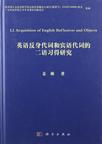英语反身代词和宾语代词的二语习得研究
出版时间:2012-5 出版社:科学出版社 作者:姜琳 页数:184 字数:316500
内容概要
L2 Acquisition of English Reflexives and Objects(英语反身代词和宾语代词的二语习得研究)探讨了英语人称代词的母语和二语习得研究。这里的人称代词包含反身代词和第三人称代词。在对相关的文献详细综述后,L2 Acquisition of English Reflexives and Objects(英语反身代词和宾语代词的二语习得研究)进行了一项实证研究,即比较高级英语水平的中国学生在英语反身代词以及宾语代词两个领域的习得。实验结果表明,他们对前者局部约束性的掌握远好于对后者有形性的掌握。这一现象可以通过语法分析理论得到解释:参数的重新设定要靠语言依据来激活;如果二语输入中缺少能够激活参数值重新设定的语言依据,那么即使处在高级英语水平阶段,二语学习者的中介语依然会呈现母语的参数值特征。
书籍目录
ContentsAcknowledgements前言AbstractChapter 1 Universal Grammar and Second Language Acquisition1.1 Introduction1.2 UG and SLA1.2.1 Principles and Parameters of UG1.2.2 SLA1.2.2.1 The Binding of Reflexives1.2.2.2 The Licensing of Null Objects1.2.3 Three Major UG-based SLA Theories1.2.3.1 The Full Transfer Full Access Hypothesis1.2.3.2 The Minimal Trees Hypothesis1.2.3.3 The Failed Functional Features Hypothesis1.3 SummaryChapter 2 Cross-Linguistic Variation on the Binding of Reflexives and Licensing of Null Objects2.1 Introduction2.2 Cross-linguistic Variation on the Binding of Reflexives2.2.1 The Parameterized Approach2.2.2 The Move-to-Infl Approach2.2.3 The Relativized SUBJECT Approach2.2.4 A New Approach to the Cross-linguistic Variation on the Binding of Reflexives2.3 Cross-linguistic Variation on the Licensing of Null Objects2.4 The Binding of Reflexives and the Licensing of Null Objects2.5 SummaryChapter 3 Studies on the Acquisition of Reflexive Binding and Null Objects3.1 Introduction3.2 Reflexive Binding in L1 Acquisition3.3 Reflexive Binding in L2 Acquisition3.3.1 Hirakawa(1990)3.3.2 Yuan(1994)3.3.3 MacLaughlin(1998)3.3.4 Thomas(1995)3.3.5 Jiang(2009b)3.3.6 White et al.(1997)3.4 Null Objects in L1 Acquisition3.5 Null Objects in L2 Acquisition3.5.1 Yuan(1997)3.5.2 Park(2004)3.6 SummaryChapter 4 Main Study4.1 Introduction4.2 The Study4.2.1 Subjects4.2.2 Materials and Procedure4.3 Results4.3.1 Reflexive Binding4.3.1.1 Group Results4.3.1.2 Individual Results4.3.1.3 Summary4.3.2 Null Objects4.3.2.1 Group Results4.3.2.2 Individual Results4.3.2.3 Summary4.3.3 Correlation between Reflexive Binding and Null Objects4.4 SummaryChapter 5 Discussion5.1 Introduction5.2 A-Binding/A'-Binding Asymmetry5.2.1 Native Language Transfer in L2 Acquisition5.2.2 Learning Strategies in L2 Acquisition5.2.3 A New Approach Involving an Interaction of the L1 Grammar and the L2 Input5.2.3.1 Morphological Complexity of the English Reflexive5.2.3.2 Binding to Non-Subjects5.2.3.3 Overt Agreement Morphology5.2.4 The Implications of the Findings for UG-based SLA Theories5.3 The Finite/Non-finite Asymmetry in the A-Binding Domain5.4 The A-bound/A'-bound Null Object Asymmetry in the A'-binding Domain5.5 ConclusionReferencesAppendix I The Main TestAppendix II The Proficiency TestList of Tables1.1 Parametric values for Turkish and German:Cevdet's three interlanguage stages(Tur=Turkish;S1=Stage 1;S2=Stage 2;S3=Stage 3;Ger=German)1.2 Accurate judgments on relative clauses(in%)2.1 Illustration of the GCP and PAP(from Manzini and Wexler 1987)2.2 Three types of binding patterns3.1 Responses of"yes"(in %)3.2 The number of subjects which are classified into each binding pattern3.3 Responses of"true"(in%)3.4 Number of subjects in each task3.5 Total omission of subjects and objects(in%)(Park 2004:5)3.6 The licensing conditions of null subjects and null objects3.7 Summary of findings of the L2 acquisition of English4.1 Subjects' background information(SD=standard deviation)4.2 Sentence types used to test L2 learners' interpretation of English reflexives4.3 Sentence types used to test L2 learners' knowledge of English overt objects4.4 Mean accuracy scores on local and LD antecedents4.5 Mean accurate judgments of LD antecedents on finite versus non-finite clauses4.6 Three types of binding patterns4.7 Classification of respondents according to the 80% consistency criterion4.8 Criteria for rejection of LD referential antecedents(RAs)and LD quantified antecedents(QAs)4.9 Number of Chinese speakers with full,partial,or no rejection of LD RAs and LD QAs according to the criteria levels set in Table 4.84.10 Overall mean accuracy scores on null objects and converted percentages4.11 Mean accuracy scores on A-bound and A'-bound null objects4.12 Error rates for Chinese speakers and native controls on each null-object sentence(percentage of errors per sentence)4.13 Number of participants giving consistent responses to null objects4.14 Accuracy scores on reflexive binding and null objects for each Chinese speaker5.1 Cevdet's three successive developmental stagesList of Figures4.1 Mean accuracy scores on local antecedents by sentence type4.2 Mean accuracy scores on LD antecedents by sentence type4.3 Mean accurate judgments(in%)of local binding and LD binding involving quantified vs.referential antecedents in the finite sentences4.4 Percentage of errors per null-object sentence4.5 Accuracy scores on reflexive binding and null objects for each L2 subject
编辑推荐
《英语反身代词和宾语代词的2语习得研究》介绍了英语代词的二语习得研究,着重比较了中国英语学习者在反身代词以及宾语代词两个领域的习得情况。 实验结果表明,被试对英语反身代词局部约束性的掌握远好于对宾语代词有形性的掌握。汉语和英语在这两个领域都存在差异,为什么他们可以很好地掌握前者,而很难掌握后者呢?针对这种不对称现象,《英语反身代词和宾语代词的2语习得研究》将从“基于普遍语法的语言习得理论”(UG-base(1 Approach)和“基于使用的语言习得理论”(Usage-based Approach)两个角度对实验结果进行全面分析,讨论三种可能的原因。
图书封面
评论、评分、阅读与下载
